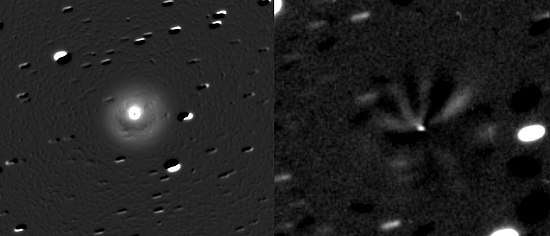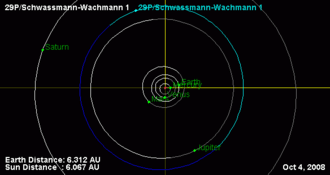29P/Schwassmann–Wachmann
Comet 29P/Schwassmann–Wachmann, also known as Schwassmann–Wachmann 1, was discovered on November 15, 1927, by Arnold Schwassmann and Arno Arthur Wachmann at the Hamburg Observatory in Bergedorf, Germany.[5] It was discovered photographically, when the comet was in outburst and the magnitude was about 13.[5] Precovery images of the comet from March 4, 1902, were found in 1931 and showed the comet at 12th magnitude.[5]
 | |
| Discovery | |
|---|---|
| Discovered by | Arnold Schwassmann Arno Arthur Wachmann |
| Discovery date | November 15, 1927 |
| Alternative designations | 1908 IV; 1927 II; 1941 VI; 1957 IV; 1974 II; 1989 XV; |
| Orbital characteristics A | |
| Epoch | March 6, 2006 |
| Aphelion | 6.25 AU |
| Perihelion | 5.722 AU |
| Semi-major axis | 5.986 AU |
| Eccentricity | 0.0441 |
| Orbital period | 14.65 a |
| Inclination | 9.3903° |
| Dimensions | 60.4 ± 7.4 km[1] |
| Last perihelion | March 7, 2019[2] |
| Next perihelion | October 31, 2033[3][4] |
The comet is unusual in that while normally hovering at around 16th magnitude, it suddenly undergoes an outburst. This causes the comet to brighten by 1 to 5 magnitudes.[6] This happens with a frequency of 7.3 outbursts per year,[6] fading within a week or two. The magnitude of the comet has been known to vary from 18th magnitude to 10th magnitude, a more than thousand-fold increase in brightness, during its brightest outbursts. Outbursts are very sudden, rising to maximum in about 2 hours, which is indicative of their cryovolcanic origin; and with the times of outburst modulated by an underlying 57-day periodicity possibly suggesting that its large nucleus is an extremely slow rotator.[7]
The comet is a member of a relatively new class of objects called "Centaurs", of which at least 400 are known.[8] These are small icy bodies with orbits between those of Jupiter and Neptune. Astronomers believe that Centaurs have been recently perturbed inward from the Kuiper belt, a disk of Trans-Neptunian Objects occupying a region extending from the orbit of Neptune to approximately 50 AU from the Sun. Frequent perturbations by Jupiter[9] will likely accumulate and cause the comet to migrate either inward or outward by the year 4000.[10]
The dust and gas comprising the comet's nucleus is part of the same primordial materials from which the Sun and planets were formed billions of years ago. The complex carbon-rich molecules they contain may have provided some of the raw materials from which life originated on Earth.
The comet nucleus is estimated to be 60.4±7.4 kilometers[1] in diameter.[9]
29P reached perihelion on March 7, 2019 and opposition on October 9, 2019.

References
- Schambeau, C.; Fernández, Y.; Lisse, C.; Samarasinha, N.; Woodney, L. (2015). "A new analysis of Spitzer observations of Comet 29P/Schwassmann-Wachmann 1". Icarus. 260: 60–72. arXiv:1506.07037. Bibcode:2015Icar..260...60S. doi:10.1016/j.icarus.2015.06.038.
- 29P past, present and future orbital elements
- Syuichi Nakano (January 29, 2012). "29P/Schwassmann-Wachman 1 (NK 2189)". OAA Computing and Minor Planet Sections. Retrieved February 18, 2012.
- Patrick Rocher (February 4, 2012). "Note number : 0015 P/Schwassmann-Wachmann 1 : 29P". Institut de mécanique céleste et de calcul des éphémérides. Retrieved February 18, 2012.
- Kronk, Gary W. (2001–2005). "29P/Schwassmann-Wachmann 1". Archived from the original on October 22, 2008. Retrieved October 13, 2008. (Cometography Home Page)
- Trigo-Rodríguez; Melendo; García-Hernández; Davidsson; Sánchez (2008). "A continuous follow-up of Centaurs, and dormant comets: looking for cometary activity" (PDF). European Planetary Science Congress. Retrieved October 13, 2008.
- Miles, Richard (July 1, 2016). "Discrete sources of cryovolcanism on the nucleus of Comet 29P/Schwassmann–Wachmann and their origin". Icarus. 272: 387–413. doi:10.1016/j.icarus.2015.11.011.
- "JPL Small-Body Database Search". Jet Propulsion Laboratory. Retrieved August 13, 2018.
- "JPL Close-Approach Data: 29P/Schwassmann-Wachmann 1" (last observation: April 10, 2009). Retrieved May 5, 2009.
- "Twelve clones of 29P/Schwassmann-Wachmann diverging by the year 4000". Archived from the original on June 23, 2015. Retrieved April 30, 2009. (Solex 10) Archived December 20, 2008, at the Wayback Machine
- Trigo-Rodriguez et al., Outburst activity in comets, I. Continuous monitoring of comet 29P/Schwassmann-Wachmann 1
- Trigo-Rodriguez et al., Outburst activity in comets , II. A multi-band photometric monitoring of comet 29P/Schwassmann-Wachmann 1 arXiv:1009.2381
External links
- Orbital simulation from JPL (Java) / Ephemeris
- 29P/Schwassmann-Wachmann 1 – Seiichi Yoshida @ aerith.net
- 29P at CometBase
- 29P at Las Cumbres Observatory (8 Feb 2010 12:23, 60 seconds)
- 29P (Joseph Brimacombe April 18, 2013)
| Numbered comets | ||
|---|---|---|
| Previous 28P/Neujmin |
29P/Schwassmann–Wachmann | Next 30P/Reinmuth |



